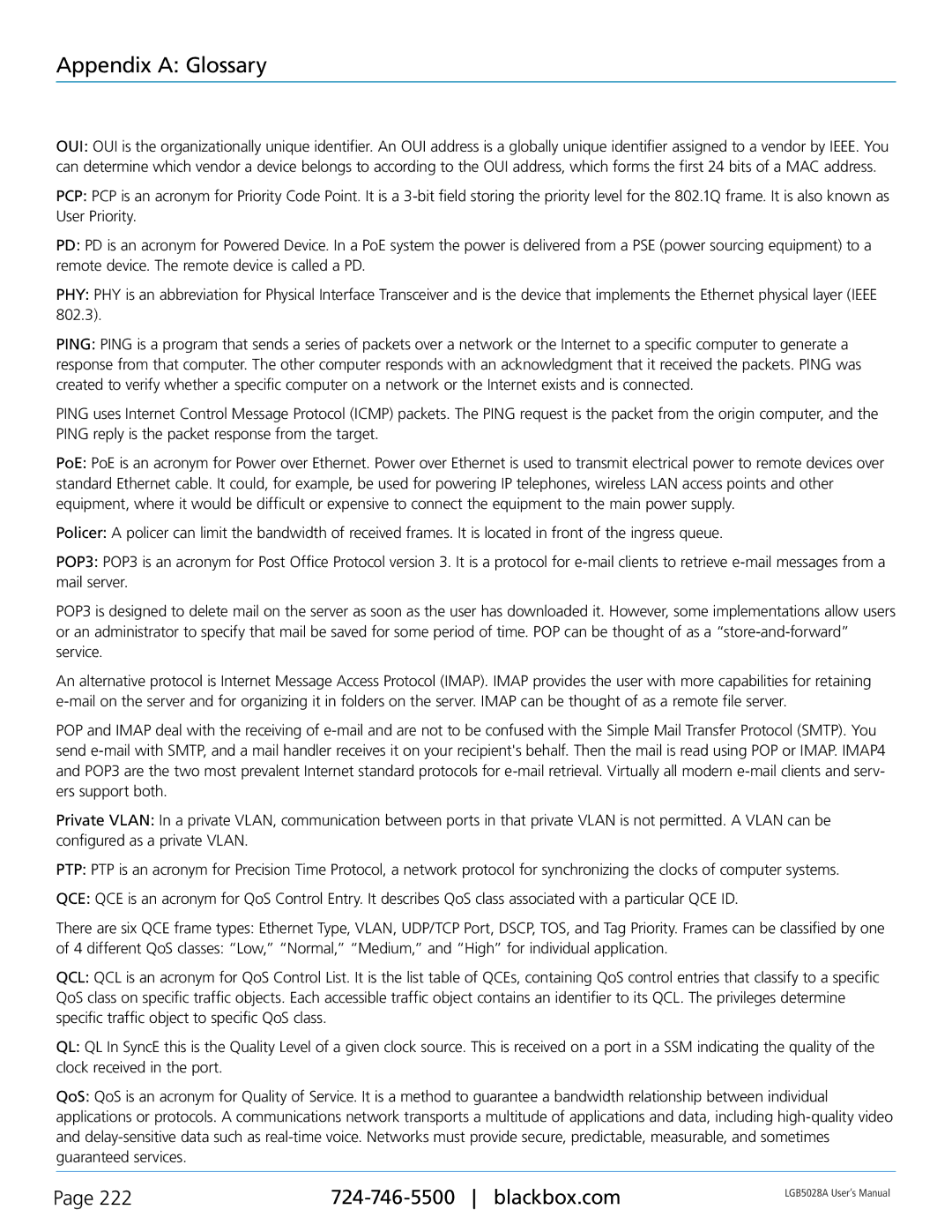
Appendix A: Glossary
OUI: OUI is the organizationally unique identifier. An OUI address is a globally unique identifier assigned to a vendor by IEEE. You can determine which vendor a device belongs to according to the OUI address, which forms the first 24 bits of a MAC address.
PCP: PCP is an acronym for Priority Code Point. It is a
PD: PD is an acronym for Powered Device. In a PoE system the power is delivered from a PSE (power sourcing equipment) to a remote device. The remote device is called a PD.
PHY: PHY is an abbreviation for Physical Interface Transceiver and is the device that implements the Ethernet physical layer (IEEE 802.3).
PING: PING is a program that sends a series of packets over a network or the Internet to a specific computer to generate a response from that computer. The other computer responds with an acknowledgment that it received the packets. PING was created to verify whether a specific computer on a network or the Internet exists and is connected.
PING uses Internet Control Message Protocol (ICMP) packets. The PING request is the packet from the origin computer, and the PING reply is the packet response from the target.
PoE: PoE is an acronym for Power over Ethernet. Power over Ethernet is used to transmit electrical power to remote devices over standard Ethernet cable. It could, for example, be used for powering IP telephones, wireless LAN access points and other equipment, where it would be difficult or expensive to connect the equipment to the main power supply.
Policer: A policer can limit the bandwidth of received frames. It is located in front of the ingress queue.
POP3: POP3 is an acronym for Post Office Protocol version 3. It is a protocol for
POP3 is designed to delete mail on the server as soon as the user has downloaded it. However, some implementations allow users or an administrator to specify that mail be saved for some period of time. POP can be thought of as a
An alternative protocol is Internet Message Access Protocol (IMAP). IMAP provides the user with more capabilities for retaining
POP and IMAP deal with the receiving of
Private VLAN: In a private VLAN, communication between ports in that private VLAN is not permitted. A VLAN can be configured as a private VLAN.
PTP: PTP is an acronym for Precision Time Protocol, a network protocol for synchronizing the clocks of computer systems.
QCE: QCE is an acronym for QoS Control Entry. It describes QoS class associated with a particular QCE ID.
There are six QCE frame types: Ethernet Type, VLAN, UDP/TCP Port, DSCP, TOS, and Tag Priority. Frames can be classified by one
of 4 different QoS classes: “Low,” “Normal,” “Medium,” and “High” for individual application.
QCL: QCL is an acronym for QoS Control List. It is the list table of QCEs, containing QoS control entries that classify to a specific QoS class on specific traffic objects. Each accessible traffic object contains an identifier to its QCL. The privileges determine specific traffic object to specific QoS class.
QL: QL In SyncE this is the Quality Level of a given clock source. This is received on a port in a SSM indicating the quality of the clock received in the port.
QoS: QoS is an acronym for Quality of Service. It is a method to guarantee a bandwidth relationship between individual applications or protocols. A communications network transports a multitude of applications and data, including
Page 222 | LGB5028A User‘s Manual | |
|
|
